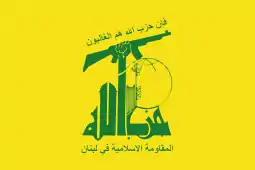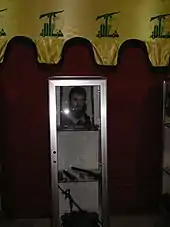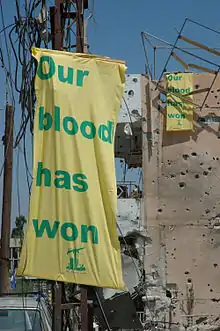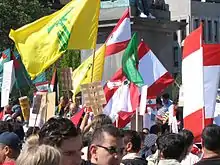Flag of Hezbollah
The flag of Hezbollah, is the flag of the Shi'a political/military organization Hezbollah. The flag depicts a stylized representation of the Arabic words حزب الله (ḥizbu-llāh, meaning "Party of God") in Kufic script. The first letter of "Allah" reaches up to grasp a stylized assault rifle.[1] The flag incorporates several other symbols, namely a globe, a book, a sword, and a seven-leafed branch. The text above the logo reads فإن حزب الله هم الغالبون (fa-inna ḥizba llāhi humu al-ġālibūna) and means "Then surely the party of God are they that shall be triumphant" (Quran 5:56), which is a reference to the name of the party. Underneath the logo are the words المقاومة الإسلامية في لبنان (al-muqāwamah al-islāmīyah fī lubnān), meaning "The Islamic Resistance in Lebanon".
 | |
| Proportion | 2:3 |
|---|---|
| Design | A yellow field emblazoned with the logo of Hezbollah in green and Arabic text in red or green. |
Symbolism
Colours

Yellow is the predominant colour on the flag and forms the basis for its field. Whilst there is no reason given for this choice of colour, vexillologist Tim Marshall has theorised that it may have been chosen to signify Hezbollah's willingness to fight for the sake of Allah and the Shi'a faith.[2]
The reasoning behind the usage of the colour green in the flag is more obvious. Green in Islamic symbolism is inextricably linked to the Islamic prophet Muhammad and the colour is mentioned numerous times within the Quran.[3][4] As a traditionally Islamic colour, the usage of green on the flag is an overtly political and explicitly religious statement.[1]
Sometimes the text on the flag appears in red lettering. The usage of red in this case is used to symbolise the blood shed by those who fell for the cause of the organization.[5]
Imagery
The symbolism of the fist grasping an assault rifle, which combines elements of the H&K G3 battle rifle and the AK-47, is two fold. The rifle is simultaneously symbolic of the party's left-wing ideological routes, sharing in the iconography of similar armed socialist movements.[2] The rifle also represents Hezbollah's belief in an armed struggle against oppressive forces.[1] However, opponents of Hezbollah interpret the inclusion of the rifle on the flag as proof that the groups aims are intrinsically tied with militant and violent action.[6]
A globe can also be found depicted on the flag, symbolizing Hezbollah's global activities.[2] Also depicted are a seven-leafed branch and a Quran, further highlighting the groups ties to Islam.[7]
Text
The central text on the flag displays the organisations name; حزب الله (ḥizbu-llāh) which translates to "Party of God".[1] The 'Alif' (first 'L' in the word Allah on the flag) extends upwards to form the fist which clenches the assault rifle.
Above the central text is found an Islamic quote (Quran 5:56) فإن حزب الله هم الغالبون . This translates to "Then surely the party of God are they that shall be triumphant" in reference to the party itself.[7]
The text below the central text states المقاومة الإسلامية في لبنان which translates to "The Islamic Resistance in Lebanon", which serves to promote the image of the groups cause as legitimate and righteous.[7]
History

Initially, Hezbollah operated under the flag of Iran as this was viewed by supporters as the flag of Islam, specifically of the Shia sect.[8] The flag of Hezbollah first saw usage in the late 1980s and early 1990s, often being displayed alongside the Iranian flag.[9]
Changes made to the flag of Hezbollah reflect the changing ideology of the party in the late 1990s and early 2000s. The two pillars of Hezbollah's ideology in the 1990s focused on an armed struggle against Israel twinned with the aim of establishing an Islamic republic in Lebanon. Referencing the latter goal, the text on the flag below the logo translated to "The Islamic Revolution in Lebanon" before 2001.[10] Yet this changed in 2001 following the reversal of a policy of hostility towards Lebanon.[11] The text was instead changed to "The Islamic Resistance in Lebanon" in order to more strongly emphasize Hezbollah's opposition towards Israel.[10][9]
The flag has remained unchanged since the early 2000s and has grown to become a globally recognised symbol of Hezbollah, yet also one representative of Islamic extremism.[1]
Use
Predominantly the flag of Hezbollah is flown by supporters and fighters of the organisation throughout the Middle East, specifically within Lebanon. The flag has recently seen extensive use by Hezbollah supporters fighting in the Syrian Civil War.[12] Internationally, the flag can be found flying at Islamic demonstrations. Notably the flag is often seen during pro-Palestinian protests, such as those held during Al-Quds day.[13][14]
Hezbollah's flag also has a more symbolic use. The flag can often be seen draped over the coffins of deceased members of the organisation, evoking a sense of martyrdom for the cause.[15][16]
Controversy

The flag of Hezbollah has often caused controversy within some western countries. Both the military and political wings of Hezbollah have been banned in a number of countries.[17][18][19] As a result it is an offence to fly or display the flag of Hezbollah within these states.
However, an exception was present within the United Kingdom. Only the military wing of Hezbollah was listed as a proscribed organisation by the Home Office in 2008 whilst the political wing remained unbanned.[20] This created a legal loophole which allowed supporters to fly the flag at demonstrations and protests throughout Britain as the flag was an official symbol of both wings. The flag could be found at protests such as at the annual Al-Quds day demonstrations and was deemed offensive by a number of groups, especially Britain's Jewish community.[6] In March 2019, the decision was made by Home Secretary Sajid Javid to include Hezbollah's political wing on the list of proscribed terrorist organisations, outlawing the flying of the flag in Britain.[21][20]
References
- Hypermedia seduction for terrorist recruiting. Ganor, Boaz., Knop, Katharina von., Duarte, Carlos. Amsterdam: IOS Press in cooperation with NATO Public Diplomacy Division. 2007. p. 203. ISBN 978-1-4356-0863-4. OCLC 181549085.CS1 maint: others (link)
- Marshall, Tim (2016). Worth dying for : the power and politics of flags. London. p. 151. ISBN 978-1-78396-282-2. OCLC 958454627.
- Smith, Whitney (1975). Flags Through the Ages and Across the World. McGraw-Hill. p. 210. ISBN 0070590931.
- "How Symbolic Is the Colour Green in Islam? The Science of Light and Colour". Amaliah. Retrieved 2020-06-08.
- "The Islamic Imagery Project: Visual Motifs in Jihadi Internet Propaganda" (PDF). Combating Terrorism Center: Department of Social Sciences United States Military Academy: 108. 2006.
- Jun 7; Opinion, 2018 |; Analysis (2018-06-07). "Revealed: The symbolism behind Hezbollah's notorious jihad flag". Christians United for Israel. Retrieved 2020-06-08.CS1 maint: numeric names: authors list (link)
- "Anti-Defamation League". www.adl.org. Retrieved 2020-06-08.
- Al-Aloosy, Massaab (2020). The changing ideology of Hezbollah. Cham, Switzerland: Palgrave Macmillan. p. 54. ISBN 978-3-030-34847-2. OCLC 1141519495.
- Saouli, Adham (2019). Hezbollah: Socialisation and its Tragic Ironies. Edinburgh: Edinburgh University Press. p. 64. ISBN 9781474419512.
- Saouli, Adham (Fall 2003). "Lebanon's Hizbullah: The Quest for Survival". World Affairs. 166: 75 – via JSTOR.
- Ranstorp, Magnus (Summer 1998). "The strategy and tactics of Hizballah's current Lebanonization process". Mediterranean Politics. 3: 103–134.
- "Ceasefire halts Syria-Lebanon border fight against Islamic State". The Irish Times. Retrieved 2020-06-09.
- Surkes, Sue. "Hezbollah flags fly as pro-Palestinian, pro-Israel demonstrators face off in UK". www.timesofisrael.com. Retrieved 2020-06-09.
- "Hezbollah flags fly at Al Quds Day rally and counter protest in London". ITV News. Retrieved 2020-06-09.
- "Lebanon's Hezbollah holds funeral for five of its fighters killed in Syria". Al Arabiya English. 2020-03-01. Retrieved 2020-06-09.
- Geraghty, Timothy J. (2009). Peacekeepers at war : Beirut 1983-the Marine commander tells his story (1st ed.). Washington, D.C.: Potomac Books. ISBN 978-1-59797-595-7. OCLC 759525242.
- "European Union designates Hezbollah's armed wing as terrorist group". The Washington Times. 22 July 2013. Retrieved 2020-06-09.
- Department Of State. The Office of Electronic Information, Bureau of Public Affairs. "Foreign Terrorist Organizations (FTOs)". 2001-2009.state.gov. Retrieved 2020-06-09.
- "Hezbollah - International terrorist organization". Israel Ministry of Foreign Affairs. Retrieved 2020-06-09.
- "UK to ban Hezbollah as terrorist organisation". BBC News. 2019-02-25. Retrieved 2020-06-09.
- Wintour, Patrick (2019-02-25). "UK to outlaw Hezbollah's political wing". The Guardian. ISSN 0261-3077. Retrieved 2020-06-09.